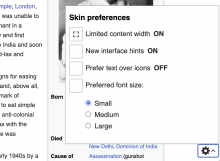GOAL
Offer a satisfying user-interface experience to as many people as possible.
We have been striving for a one-size-fits-all interface. In contrast this solution offers users with very common disabilities and impairments, which we know the current interface doesn't offer best experience, an easy way to adapt the interface to their needs and to serve them the best we could.
- What DONE looks like **
- Mobile and desktop have a unified control for changing font size.
- Special:MobileOptions is only shown to logged in users
What to offer
We’re talking about flexibility in changing basic settings (still to clarify needs, define and test) like
- font size,
- day/night modes,
- photophobia,
- grayscale,
- …
For whom
For all readers including not-logged-in ones.
Technical limitation to support it for every user is, that it has to be implemented client-side in JavaScript to avoid cache fragmentation.
Where and how
Some early mockups:
And more recently discussed “reader“ settings (design and location) over at https://www.mediawiki.org/wiki/Beta_Features/Hovercards/preferences
Related is question to consolidate important reader preferences (appearance, language, accessibility preferences) into one location, which is also a good part of the discussion on the Hovercards preferences.
Separation to other accessibility improvements
In general, with WMF's vision of ”every single human being”, we try to provide broadest-possible support. But with given technical constraints we need to balance the different needs. At T111117 there are for example tasks collected, that can be baked-in per default into our software products, others like above mentioned font-size, day-night modes etc. are better built as preferences and decided on a per-user base, as there's not one solution fits all.
Relevant discussion on: T72879: Simple accessibility preferences
Version: 1.24rc



